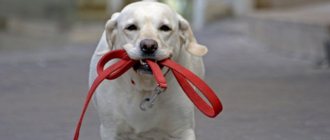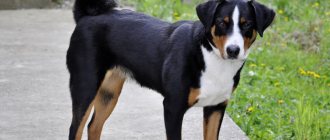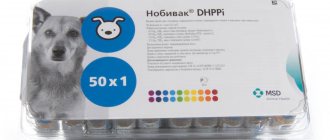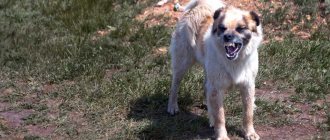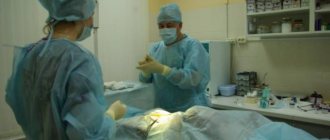- October 19, 2018
- Dogs and hunting with them
- Galina Chebykina
After what vaccination can you walk your puppy? This question interests all people who have a pet and are going to care for it and monitor its health as it should be. Today we offer to learn about what vaccinations an animal must have before it reaches one year of age, and what rules to follow before and after vaccination. You will find out how long you should not walk your dog after vaccination and why.
First vaccination
A respectable breeder will not take a puppy from its mother until the age of 4 weeks, since it is during this period that the baby develops passive immunity through the milk of an adult dog. In this age period, morbidity is very rare.
But is it possible to go for a walk, the puppy’s first vaccination has not been given, but he lives with his mother? The baby has immunity, but it is still weak; the puppy can easily become infected from other animals, from toys, human shoes, and so on. Before the first vaccination, your pet must not have contact with animals that are not vaccinated, and you cannot walk with it either!
At the age of 8 to 12 weeks, the baby becomes extremely susceptible to various types of diseases; it is during this period that the first vaccine is recommended. Next, you need to follow safety rules after vaccination. How long after can a puppy go for a walk? Immunity is developed over the course of 21 days, then re-vaccination is carried out, at the same time vaccination against rabies is carried out. Then the animal again develops immunity over the course of 21 days. Knowing this schedule, you can easily calculate when you can walk your puppy after vaccination.
At what age can you start walking puppies?
When can you take your puppy outside for walks after the first vaccination?
From birth to 1.5-2 months, puppies are protected by the mother's immunity. As long as they are with her, they are not in danger even when communicating with other animals. But immediately after weaning, the puppy becomes vulnerable. Without immunization, you should absolutely not go for walks with him.
Puppy vaccination
A two-month-old puppy receives the first mandatory vaccination (the second, if we count the optional one for parvovirus enteritis). Two weeks after it, if the pet feels well, you can start walking.
Important to remember ! After this vaccination, the pet does not yet have immunity against rabies. When planning your walking route, you need to take this fact into account. It is unlikely that it would be correct to walk him in places frequented by wild animals (fox, raccoon).
At first, you need to pay more attention to your pet’s well-being. If signs of discomfort are observed after a walk, walks should be suspended until the reasons are fully clarified.
There are general rules that need to be followed during the first time after vaccination:
- The optimal temperature for walking in winter is up to -10°C, in summer up to +30°C.
- Windless, calm place.
- In the first 7-10 days you should not be exposed to rain.
- During the first month, loads should be normalized. It’s better to walk more often, but not for long. Each time 20-25 minutes is enough.
Important ! You should not take the puppy out for a walk immediately after feeding.
It is very important to motivate your dog. While walking, he can be frightened by very simple objects and phenomena. It is important to show the pet that the owner is nearby and the danger is insignificant. Affectionate stroking and tasty treats will distract and calm him down. To keep the puppy from freezing, he should be constantly encouraged to move, but in a way that makes him happy.
Dog lovers need to understand that each of the components of a complex vaccine has its own time period for the onset of protection. Full protection occurs after the first mandatory vaccination within a week, with the exception of leptospirosis and rabies. Therefore, the doctor indicates the period after which immunity is developed against all the diseases listed in the complex.
As for walks until the end of quarantine (and generally after weaning), they can be continued if you are sure that:
- fenced area;
- has never been visited by other animals (or has undergone preventive treatment);
- well protected from the wind;
- illuminated by the sun.
Therefore, the decision on how long the dog cannot be walked after vaccination is made by the dog’s owner himself.
Vaccinations up to one year
We suggest that you familiarize yourself with the recommended vaccination schedule. Keep it for yourself, because knowing after what vaccination you can walk your puppy, you will be able to find out at what age you will start walking, and protect the animal from contracting dangerous diseases.
- Not always at 3-4 weeks, but the first PUPPY vaccination is given. The vaccine is required only in the most extreme cases: the mother is infected, there is an epidemic in the nursery, the risk of infection of the baby is high. Do not confuse this with the first mandatory vaccination, which will begin the 21-day countdown to the second, and then to the third—against rabies.
- At the age of 8-10 weeks, the dog is given the first vaccination, which develops immunity against distemper, enteritis, hepatitis, parainfluenza, and leptospirosis. As you understand, this is a mandatory vaccination for puppies. When can you go for a walk? It is not recommended to rush, it is better to wait for the third vaccination, and only after that take the baby outside. If there is no choice and the puppy needs to be placed with other animals or taken out into the yard, then do this no earlier than the 14th day after vaccination, since immunity only develops over the course of 2 weeks, and quarantine is necessary.
- 3 weeks after the first vaccination, that is, at the age of 11-13 weeks, the dog is given a second vaccination - a revaccination is carried out, which strengthens the immunity. This vaccination is also mandatory, but only for puppies; subsequent annual vaccinations are administered once. When can a puppy go for a walk after the second vaccination? It is advisable to postpone all walks for another 2-3 weeks and keep the baby in quarantine.
- The rabies vaccine is administered along with the second vaccination. It can be postponed until six months, if until this time the puppy will definitely not have contact with other animals. If you do not vaccinate immediately, then for the safety of both the animal and yours, postpone all walks and accustom your dog to only a diaper at home for now.
- At 6-7 months they give a third vaccination against distemper, enteritis and all other diseases prescribed above. Walking is not recommended for 2 weeks after vaccination.
- The fourth vaccination follows at one year of age. Again, you need to quarantine for 2 weeks.
At what age are puppies vaccinated?
Is it possible to wash a dog after vaccination: after how long is it allowed?
From birth to one and a half months, puppies grow up breastfed. They receive all the necessary protective equipment from the vaccinated mother. After weaning, puppies require external protection. To do this, it is recommended to start vaccinating them from 6 weeks. The first vaccination is done in the nursery. It is not mandatory, but desirable. This is protection against parvovirus enteritis. For this purpose, one of the drugs is used: “Eurikan”, “Primo”, “Nobivak Pappy”, “Multican”.
First vaccination
Mandatory vaccinations begin no later than 8 weeks. The second (mandatory) vaccination is complex. It protects against:
- parvovirus enteritis;
- plague;
- infectious laryngotracheitis;
- infectious hepatitis;
- parainfluenza;
- leptospirosis.
If the nursery dispenses with the optional one, this complex one is considered the first.
At 3 months the third vaccination is indicated. The puppy needs it. It includes the entire composition of the second complex, but adds an anti-rabies component. By the way, annual revaccination against rabies is required.
If necessary (if the dog often suffers from infectious diseases), it is recommended to repeat the complex vaccination at 4 months, as with the third vaccination. This is the fourth immunization. It is optional and is carried out only according to medical indications.
Inactivated or attenuated vaccines: what is the difference, which one to choose?
Attenuated vaccine. In this case, a small amount of live, weakened viruses is injected into the animal. Once in the blood, viruses begin to multiply, causing the formation of immunity to fight them. The puppy suffers from the disease, but in a weak form, immunity is developed quickly, after a week it is persistent and lasts up to three years!
Inactivated vaccine. This is a larger amount of the injected virus, it does not multiply, immunity is developed more slowly and lasts only a few months.
After what vaccination can you take your puppy for walks before? Theoretically, after attenuated, because immunity is developed within a week. But veterinarians recommend that in both cases it is better to wait the recommended time, and schedule walking only after quarantine after the 2nd vaccine.
Rules for walking a puppy without vaccinations
They are dictated by common sense and do not need explanation. The only thing that should be taken into account is the difference between urban and suburban areas where the puppies will frolic.
In the country
People who live year-round in cottages, their own houses or dachas are in the most advantageous position . On the adjacent (internal) territory, the dog can roam without fear of stumbling into other people's feces.
Important! Before letting your dog into the yard, free it from traumatic objects and debris (carrion), and also check the integrity of the fence/fence so that the pet does not jump out.
If he is already a month old, teach him to use a leash and muzzle in order to make longer trips. The main thing is not to let him pick up any nasty things from the ground and come into contact with unfamiliar dogs.
In the city
Here it is important to teach your baby to hear you and obey the first call, to teach him to move together when called “nearby” (without pulling on the leash) and to stop when called “to me.”
Another key command is “fu”: it is pronounced strictly and clearly as soon as the puppy gets carried away with street scum. The forbidden object must be taken away, or even better, the dog must not be allowed to grab it.
A small puppy is carried more in your arms, releasing it in proven safe places. The pet is accustomed to noise and various surfaces as early as possible, but with caution and in doses.
Duration of walking
With a puppy who is not even 3 months old, go for a short (up to an hour) walk at least once a day, prolonging the stay outside in clear, warm weather. If the puppy does not feel very comfortable, return home with him immediately after he relieves himself.
Contact with other puppies
Communication with your own kind is necessary for the development of friendliness, so allow the puppy to contact his relatives . A lack of communication can lead to hypertrophied aggression or unreasonable cowardice in the future.
Important! Do not allow your puppy to come into contact with stray animals and be selective about pet dogs. Not all owners vaccinate their four-legged animals, and this is a risk for healthy pets in contact with them.
Is quarantine mandatory?
If your dog is not vaccinated or quarantined before and after vaccinations, it can become infected with one of the following diseases:
- plague;
- parainfluenza;
- enteritis;
- rabies;
- leptospirosis;
- infectious hepatitis.
Whether to get the first two and subsequent vaccinations or not is up to you, but in Russia it is mandatory to vaccinate animals against rabies! If you do not comply with the recommended quarantine and walk before vaccinations or immediately after them, then there is a high probability that the animal will get sick. Of course, today veterinary medicine has stepped very far forward, but even if the dog does not die, during the illness he will be severely exhausted, and irreparable harm will be caused to the body.
How are puppy vaccinations done?
First vaccination. In the first days of life, a newborn dog takes protection from its mother’s milk; the antibodies contained in the milk quickly eliminate vaccine strains and do not allow the baby’s immunity to fully strengthen. The initial vaccine is given when the baby reaches 8-9 weeks. At the indicated time, the dog’s antibody level is reduced.
A two-stage puppy vaccination scheme, or “Vaccination Schedule,” is used.
The first stage is the first vaccination, which is given to puppies at forty days. The puppy’s immunity is not formed at a young age; it is not recommended to vaccinate earlier than required. At six weeks there is a sharp decrease in the level of antibodies, and susceptibility to infectious diseases appears.
The second stage is a booster vaccination given after reaching eleven or twelve weeks. After the second vaccination, as after the first, two weeks pass until strong immunity is developed.
It is strongly recommended to adhere to a schedule that determines the health and well-being of your little pet.
When the vaccination stages are completed, the puppy’s body is too weakened and vulnerable to infections and diseases. After two weeks, the immune system becomes stable and strong. However, during this period it will be necessary to exclude walks outside the home; there are an excess of sources of infections on the street. It is not recommended to wash or expose the puppy to overheating, hypothermia, stressful conditions, overwork, physical activity and time-consuming transportation. Consider the important point - the incubation period is maintained after the first vaccination and after revaccination.
Imported or domestic vaccines?
After which vaccination can you take your puppy for walks first - after imported or domestic? There is absolutely no difference here! When choosing a vaccine from any manufacturer, you must prepare the dog (we’ll tell you how to do this later) and withstand quarantine.
Imported vaccines are more expensive than domestic ones, and many therefore believe that their quality is higher and choose them. But veterinarians insistently recommend that puppies be vaccinated against distemper only with a Russian-made vaccine, since after imported vaccinations there have been cases of infection with this disease, even though the owners vaccinated the dogs following all the rules.
In any case, the veterinarian will advise you on everything himself and tell you about the advantages and disadvantages of any vaccine produced.
Bumps after dog vaccination
Vaccination is quite difficult, but after vaccinations, unpleasant phenomena such as bumps may appear on the animal.
In most cases, this problem resolves itself and its occurrence does not cause anything terrible for the health of the pet, however, some compactions can persist for quite a long time at the site of vaccination.
The practice of the appearance of post-vaccination complications, such as bumps, shows that their complete disappearance occurs after about a few days, which should not cause any concern. If you still don’t complete the education, then you should consult with an experienced veterinarian to eliminate threats to your pet’s health.
Preparing the puppy for vaccination
Only a completely healthy animal should be vaccinated, and the veterinarian will definitely check this. If the puppy is already sick, then vaccination will not help, it will only worsen his condition. This is not a cure, it is the virus itself, only weakened.
To avoid the negative consequences of vaccination, follow these rules:
- A week before vaccination, start measuring the animal’s temperature every day and examining its mucous membranes.
- After vaccination, you cannot walk for at least two weeks! The first walks should be made only in a clean area, without other animals.
- Contact with other animals only 21 days after vaccination.
- If the vaccination is in the morning, then do not feed the animal in the evening; if in the evening, then the last meal is 4 hours before. Vaccination is easier to tolerate on an empty stomach. You can give him something to drink.
Even if all the rules are followed, the animal will feel worse after vaccination. The vaccination itself is stressful, and the virus will begin to awaken the immune system. You shouldn’t worry too much, but you need to give the puppy more attention and care during rehabilitation.
Is contact with other puppies allowed?
During quarantine, communication with other puppies is not recommended. It's another matter if they are from the same litter and vaccinated at the same time.
For the first and second vaccinations of a puppy, the quarantine period is at least 2 weeks. When immunized against rabies, this period is extended to 3 weeks.
The following rules must be followed:
- walk exclusively with a puppy in your arms;
- avoid walking areas of other dogs;
- no bathing;
- Avoid contact with street shoes and door mats.
Deworming
Even those babies who feed only on mother’s milk and do not come into contact with other animals must be treated against parasites before vaccination. If this is not done, then the vaccine will be of no use.
Anti-helminth medications are used 2-3 weeks before the day scheduled for vaccination. Choose the drug carefully; it is better to choose one that is used once. If you choose the one that needs to be applied twice, then you will have to start preparing the puppy from the age of one month in order to have time to carry out the second cleaning before vaccination.
Rules for walking after vaccination
We figured out when you can walk your puppy after vaccination, now we’ll find out how to do it correctly. After the first vaccine, after 2 weeks you can take your pet outside for a short time, but only in your arms, you cannot let it down to the ground! The first full walk can be scheduled on the 11-14th day after the second vaccination. Observe the following rules:
- Choose a sunny day without wind.
- Find a quiet place where there is no trash, other animals or strangers.
- For the first time, a 20-minute walk is enough.
Before you take your puppy outside, make sure he is in good health. He should not have a fever, lethargy or drowsiness. If the baby is active, eats well and plays, then feel free to take him to get acquainted with the world around him!
What to do if you missed a vaccination
The vaccination schedule established by the doctor cannot be changed without permission, especially when it comes to primary vaccinations. Subsequently, revaccination is carried out every year, but the timing of the first injections is extremely important.
If the owner missed the deadline for administering the vaccine, one should be prepared for the fact that immunity will not be fully developed, that is, it will not be 100% stable. Sometimes skipping an injection is due to the pet's illness.
If you miss the time for administering the vaccine, you will have to take the course of this vaccination again and only after quarantine will the dog be able to go outside for a walk.
The first year of a puppy's life is very important for its entire life. It is possible to form an immune system resistant to infections only through vaccination. The vaccination schedule should be strictly followed; this is the only way your four-legged pet can get a healthy foundation for its future existence.

